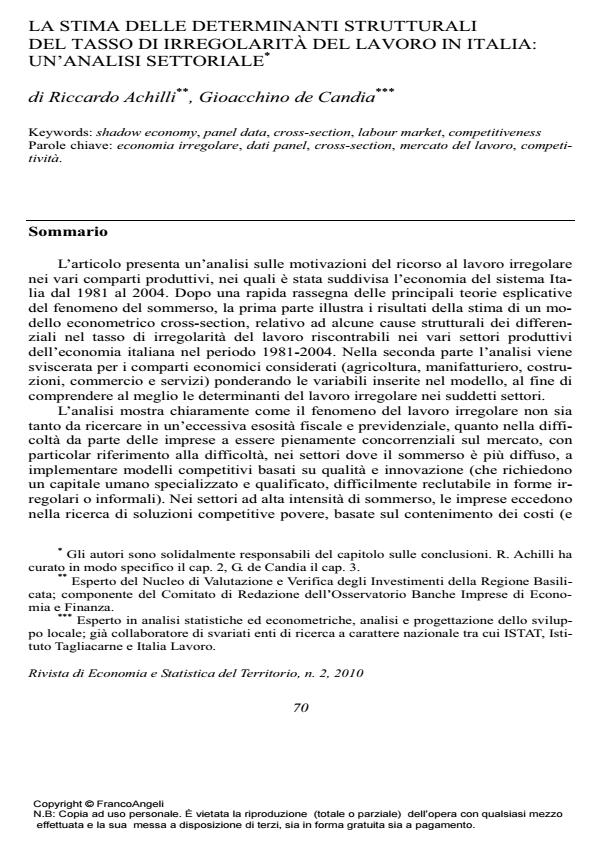Structural factors of shadow labour rate in Italy: a sectorial analysis
Journal title RIVISTA DI ECONOMIA E STATISTICA DEL TERRITORIO
Author/s Riccardo Achilli, Gioacchino de Candia
Publishing Year 2010 Issue 2010/2
Language Italian Pages 33 P. 70-102 File size 374 KB
DOI 10.3280/REST2010-002004
DOI is like a bar code for intellectual property: to have more infomation
click here
Below, you can see the article first page
If you want to buy this article in PDF format, you can do it, following the instructions to buy download credits

FrancoAngeli is member of Publishers International Linking Association, Inc (PILA), a not-for-profit association which run the CrossRef service enabling links to and from online scholarly content.
This article analyses some of the main causes of the use of shadow labour in the productive sectors of Italian economy in the 1981-2004 period. After a brief review of the main theories explaining the shadow economy, first part of the article presents the results of the estimation of a cross-section econometric model, based on 120 observations, over the 1981-2004 period. This empirical study is aimed at identifying some of the main structural factors explaining the overall differences in the irregular labour rate between the main productive sectors in the Italian economy. Then, the second part of the article goes more in depth in each single productive sector (agriculture, manufacturing, construction industry, commerce and other services) in order to trace some sector-specific cause in the use of irregular labour. Methods and Results The analysis shows that the level of shadow economy doesn’t depend on excessive fiscal or social security costs. The main cause relies on the difficulty of firms to become more competitive in final consumption markets, especially in terms of a competitive model based on quality and innovation, requiring high skilled and high specialised labour force (which is more difficult to hire through informal or irregular forms). In the sectors in which there is a high irregularity rate, firms tend to exceed in the search of low production costs (i.e. low labour costs). Sectorial labour markets characterised by large use of flexible, precarious labour force, especially for non skilled or poorly specialised workers, are consistent with this "poor" approach to competitiveness, and a widespread use of flexible, unstable workers seem to be associated with high diffusion of shadow economy. Conclusions Even if there are some sectorial differences in explaining the structural causes of shadow economy, it seems that the lack of productive specialisation is a "fil rouge", connecting all the areas of the economy where a high irregularity rate can be found. A policy aimed at reducing the shadow economy must be addressed, thus, to systemic factors, and cannot be reduced to mere financial or fiscal incentives (like it has been done in Italy, with poor results). It has to be addressed to the structural aspects of the competitive model of firms, to the functioning of labour market, and to the adequacy of our educational and vocational training system.
Keywords: Shadow economy, panel data, cross-section, labour market, competitiveness
Jel codes: C23, O17, J63
- Social Capital and Undeclared Work: An Empirical Analysis in Italy from 1998 to 2008 Maria Felice Arezzo, in Social Indicators Research /2014 pp.695
DOI: 10.1007/s11205-013-0434-4
Riccardo Achilli, Gioacchino de Candia, La stima delle determinanti strutturali del tasso di irregolarità del lavoro in Italia: un'analisi settoriale in "RIVISTA DI ECONOMIA E STATISTICA DEL TERRITORIO" 2/2010, pp 70-102, DOI: 10.3280/REST2010-002004